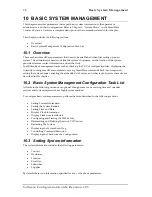
90
IP
Context
Overview
destination-network entry, the router adds one to the metric value indicated in the update and enters
the network in the routing table. The IP address of the sender is used as the next hop.
RIP prevents routing loops from continuing indefinitely by implementing a limit on the number of
hops allowed in a path from the source to a destination. The maximum number of hops in a path is
15. If a router receives a routing update that contains a new or changed entry, and if increasing the
metric value by one causes the metric to be infinity (that is, 16), the network destination is considered
unreachable.
For information and examples on how to configure Routing Information Protocol (RIP) refer to
Chapter 18, “Routing Information Protocol (RIP) Configuration” later in this user guide.
11.9 Configuring Access Control Lists
Packet filtering helps to control packet movement through the network. Such control can help to
limit network traffic and to restrict network use by certain users or devices. To permit or deny
packets from crossing specified interfaces, SmartWare provides access control lists.
An access control list is a sequential collection of permit and deny conditions that apply to packets
on a certain interface. Access control lists can be configured for all routed network protocols (IP,
ICMP, TCP,UDP, and SCTP) to filter the packets of those protocols as the packets pass through a
SmartNode. SmartWare tests packets against the conditions in an access list one by one. The first
match determines whether SmartWare accepts or rejects the packet. Because SmartWare stops testing
conditions after the first match, the order of the conditions is critical. If no conditions match, the
software rejects the address.
For information and examples on how configure access control lists refer to Chapter 19, “Access
Control List Configuration” later in this user guide.
11.10 Configuring Quality of Service
In SmartWare the link scheduler allows the definition of quality of service (QoS) profiles for network
traffic on a certain interface, as shown Figure 11-1 on
86. Qo
page
S refers to the ability of a network
to provide improved service to selected network traffic over various underlying technologies
including Frame Relay, Ethernet and 802.x type networks, and IP-routed networks. In particular,
QoS features provide improved and more predictable network service by providing the following
services:
•
Supporting dedicated bandwidth
•
Improving loss characteristics
•
Avoiding and managing network congestion
•
Shaping network traffic
•
Setting traffic priorities across the network
The SmartWare QoS features described in Chapter 15, “Link Scheduler Configuration” later in this
user guide address these diverse and common needs.
Software Configuration Guide, Revision 1.03
Summary of Contents for SmartWare R2.00
Page 2: ......
















































